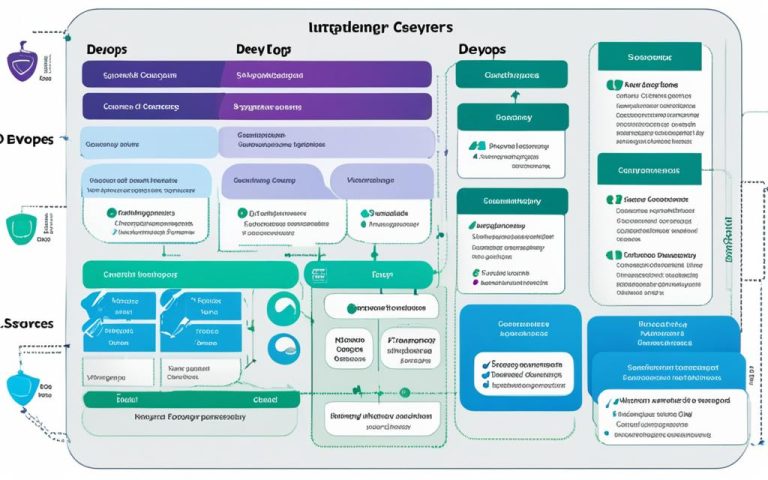Cloud configuration management plays a crucial role in optimizing the efficiency of hardware and software in organizations migrating to the cloud. By implementing the right cloud configuration tools, businesses can streamline their networking processes and enhance overall productivity.
In this article, we will explore the top configuration management tools that are specifically designed to support efficient cloud networking. These tools offer automation, facilitate infrastructure management, and ensure seamless configuration control.
Configuration management is the process of maintaining consistency and control over the software and hardware components within a cloud environment. It involves managing the configuration settings and parameters of various systems and applications, ensuring that they work together harmoniously.
Efficient cloud networking requires robust configuration management tools that can automate tasks, manage server environments, provision resources, and optimize overall network performance. By leveraging the power of these tools, organizations can reduce manual overhead, increase scalability, and improve operational productivity.
In the next sections, we will delve deeper into the top configuration management tools available in the market. We will explore their key features, strengths, and use cases, helping you make an informed decision about which tool is best suited for your organization’s cloud networking needs.
Top Configuration Management Tools
When it comes to efficient cloud networking, having the right configuration management tools is crucial. These tools streamline infrastructure management, automate processes, and ensure faster provisioning. In this section, we will explore some of the top configuration management tools that cater to the automation and infrastructure management needs of organizations.
Puppet
Puppet is an efficient configuration management tool that excels in IT inventory management. With its declarative language and organized modules, Puppet simplifies system configuration by describing it in a structured manner. This tool allows for efficient management of infrastructure, configuration, and deployment.
Chef
Chef is a powerful platform for managing servers in the cloud, on-premises, or in a hybrid environment. Similar to Puppet, Chef focuses on infrastructure management, configuration, and deployment. It offers flexibility and scalability in managing various systems and ensuring consistency across environments.
Ansible
Ansible is an open-source configuration management tool known for its automation capabilities. It simplifies provisioning, configuration management, orchestration, and deployment tasks. Ansible’s simplicity and versatility make it a popular choice for cloud configuration management.
Terraform
Terraform, while not explicitly a configuration management tool, has gained popularity for streamlining resource initialization. It provides a higher-level abstraction of the data center and relevant resources, making it easier to manage infrastructure. Terraform can be integrated with other configuration management tools for comprehensive cloud environment management.
SaltStack
SaltStack is an intelligent automation software that excels in managing cloud environments. It integrates seamlessly with popular cloud providers such as Amazon Web Services (AWS) and Google Cloud. With its event-driven architecture and scalability, SaltStack offers efficient and reliable automation for cloud configuration management.
The aforementioned configuration management tools are widely recognized for their ability to automate infrastructure management, comply with security standards, and provide faster provisioning. Each tool has its own unique features and strengths, allowing organizations to choose the one that best aligns with their cloud configuration needs.
Next, we will explore Puppet in detail, focusing on its efficient IT inventory management capabilities.
Puppet – Efficient IT Inventory Management
Puppet is a powerful cloud configuration management tool that excels in IT inventory management. With its declarative language and organized modules, Puppet simplifies the process of describing and managing system configurations. Organizations can leverage Puppet’s capabilities to efficiently handle infrastructure, configuration, and deployment tasks.
Puppet’s declarative language allows users to define the desired state of their IT inventory. By using Puppet’s modules, which are pre-packaged resources and instructions, administrators can easily manage various aspects of their infrastructure. These modules serve as building blocks for defining and enforcing configuration settings across multiple systems.
The efficiency of Puppet lies in its ability to scale and automate IT inventory management processes. Administrators can define how systems should be configured, and Puppet automatically ensures that the desired state is maintained. This eliminates the need for manual intervention and reduces the risk of human errors.
Key Features of Puppet
- Declarative language for defining system configuration
- Organized modules for efficient IT inventory management
- Automation of infrastructure, configuration, and deployment processes
- Scalability to handle large-scale IT environments
- Centralized control and monitoring of system configurations
“Puppet provides a comprehensive solution for managing IT inventory in the cloud. Its declarative language and modular approach make it easy to define and enforce system configurations. With Puppet, organizations can streamline their inventory management processes and ensure consistent and efficient operation of their cloud infrastructure.”
By leveraging Puppet’s capabilities, organizations can achieve greater efficiency in managing their IT inventory. The use of declarative language and modules simplifies the process of system configuration, ensuring consistent and reliable results. Whether it is provisioning new resources, updating configurations, or deploying applications, Puppet offers a robust solution for IT inventory management.

Continue reading to learn about another popular configuration management tool – Chef – and its role in managing servers in the cloud.
Chef – Managing Servers in the Cloud
Chef is a powerful platform for managing servers in various environments, including the cloud, on-premises, and hybrid setups. With Chef, organizations can streamline their server management processes and ensure the efficient operation of their infrastructure.
Similar to Puppet, Chef focuses on managing infrastructure, configuration, and deployment. It provides a comprehensive set of tools and resources to automate tasks and maintain consistency across servers in different environments.
One of the key advantages of using Chef is its ability to manage servers in a hybrid environment. This is especially beneficial for organizations that have a mix of on-premises infrastructure and cloud resources. Chef allows seamless integration and orchestration of servers in both environments, providing a unified management experience.
With Chef, organizations can define their infrastructure as code, enabling the consistent deployment and configuration of servers. It uses a declarative language called “recipes” to specify the desired state of each server, ensuring that configurations are applied correctly and consistently.
Moreover, Chef comes with a vast collection of community-maintained cookbooks, which are pre-built configurations for common server setup and management tasks. These cookbooks can be easily customized to suit specific requirements, saving time and effort in setting up and maintaining servers.
“Chef simplifies server management in cloud, on-premises, and hybrid environments, allowing organizations to automate tasks, maintain consistency, and streamline their infrastructure.”
In a hybrid environment, Chef enables organizations to seamlessly manage servers across different platforms, such as AWS, Azure, and on-premises data centers. It provides a unified view of the infrastructure and simplifies the deployment and configuration of servers, ensuring efficient server management in complex environments.
Benefits of Chef for Server Management:
- Efficient management of servers in the cloud, on-premises, and hybrid environment.
- Consistent deployment and configuration of servers through infrastructure-as-code.
- Extensive collection of community-maintained cookbooks for common server tasks.
- Seamless integration and orchestration of servers across different platforms.
- Unified management experience for diverse server environments.
With Chef, organizations can take full control of their server management processes and ensure the reliable and efficient operation of their infrastructure in any environment.
| Features | Benefits |
|---|---|
| Infrastructure as code | Consistent server deployment |
| Declarative language | Efficient configuration management |
| Community-maintained cookbooks | Time and effort savings on server setup |
| Hybrid environment support | Unified management experience |
| Seamless integration | Efficient orchestration of servers |
With its robust features and versatile capabilities, Chef is a valuable tool for organizations seeking efficient server management in cloud, on-premises, and hybrid environments.
Ansible – Automation for Provisioning and Configuration Management
In the realm of cloud configuration management, Ansible stands out as a powerful open-source tool that offers automation for provisioning, configuration management, orchestration, and deployment. With its simplicity and versatility, Ansible enables organizations to automate various tasks in cloud configuration management, streamlining operations and enhancing efficiency.
Ansible’s strength lies in its ability to automate the provisioning and configuration management of cloud networks, eliminating manual, repetitive tasks. By defining desired states in a playbook, Ansible executes actions consistently across multiple systems, ensuring uniformity in configurations and deployments. This automation capability saves valuable time and effort for IT teams, enabling them to focus on more strategic initiatives.
With Ansible, organizations can easily define and manage infrastructure as code. Using its declarative language, Ansible allows users to specify the desired state of systems, applications, and environments, enabling seamless configuration management. This approach ensures system reliability, reduces the chances of configuration drift, and enhances overall system stability.
“Ansible’s automation capabilities for provisioning and configuration management empower organizations to optimize their cloud networks efficiently.” – Industry Expert
Ansible’s orchestration features enable the execution of complex tasks and workflows, making it a valuable tool in managing intricate cloud environments. By defining dependencies and sequences, Ansible ensures that tasks are executed in the correct order, minimizing errors and improving system reliability.
Furthermore, Ansible’s deployment automation capabilities enable organizations to streamline the process of deploying applications and updates across their cloud infrastructure. With Ansible, application deployments become easily repeatable and highly scalable, facilitating rapid and efficient delivery of new features and enhancements.
Advantages of Ansible for Provisioning and Configuration Management
Utilizing Ansible for provisioning and configuration management offers several benefits:
- Automation: Ansible automates repetitive tasks, reducing manual effort and human errors.
- Flexibility: Ansible supports multiple cloud providers and system architectures, allowing for seamless integration into existing environments.
- Scalability: Ansible scales effortlessly to manage large and complex cloud networks, providing consistent configuration management.
- Extensibility: Ansible’s open-source nature allows for easy customization and integration with existing tools and systems.
- Cost Efficiency: By automating tasks and enabling efficient system management, Ansible helps optimize resource utilization, resulting in cost savings.
Comparison of Configuration Management Tools
| Tool | Strengths |
|---|---|
| Ansible | Simplicity, versatility, automation capabilities |
| Puppet | IT inventory management, declarative language |
| Chef | Server management, hybrid environment support |
| Terraform | Streamlining resource initialization, higher-level abstraction |
| SaltStack | Intelligent automation, event-driven architecture |
Terraform – Streamlining Resource Initialization
While not explicitly classified as a configuration management (CM) tool, Terraform has gained popularity for its ability to streamline resource initialization in cloud environments. Terraform offers a higher-level abstraction of the data center and relevant resources, providing a structured approach to provisioning and configuration management.
With Terraform, organizations can define infrastructure as code, using a declarative language to describe the desired state of their cloud resources. This approach allows for the management of complex infrastructure setups with ease, ensuring consistency and reliability across environments.
Terraform’s key strength lies in its ability to integrate with other CM tools, enabling seamless collaboration between various systems. By leveraging Terraform alongside CM tools such as Puppet, Chef, Ansible, and SaltStack, organizations can achieve a comprehensive and efficient cloud configuration management workflow.
Utilizing Terraform’s higher-level abstraction, cloud administrators can provision and manage resources, including virtual machines, storage, networking, and more. The declarative nature of Terraform enables users to express their infrastructure requirements in a simple and readable format, driving efficient resource initialization.
“Terraform’s higher-level abstraction simplifies resource initialization, allowing cloud administrators to focus on the big picture of their infrastructure requirements.”
By adopting Terraform as part of their cloud configuration management strategy, organizations can benefit from the following:
- Improved scalability: Terraform enables the management of infrastructure at any scale, allowing organizations to grow and adapt as needed.
- Higher-level abstraction: With Terraform’s intuitive syntax, users can define complex infrastructure setups, reducing the burden of manual configuration.
- Efficient resource allocation: Terraform allows for the efficient provisioning and allocation of cloud resources, optimizing utilization and minimizing costs.
- Seamless integration: Terraform can easily integrate with existing CM tools, providing a cohesive workflow for configuration management.
Overall, Terraform serves as a valuable addition to any cloud configuration management toolkit, providing a streamlined approach to resource initialization and management. By leveraging its higher-level abstraction and integration capabilities with CM tools, organizations can achieve greater efficiency and consistency in their cloud infrastructure deployment.
Take a look at the table below for a comparison of Terraform and other popular CM tools:
| Tool | Primary Focus | Language | Integration with Terraform |
|---|---|---|---|
| Terraform | Resource Initialization | HCL (HashiCorp Configuration Language) | N/A |
| Puppet | IT Inventory Management | Puppet DSL | Yes |
| Chef | Server Management | Ruby-based DSL | Yes |
| Ansible | Provisioning and Configuration Management | YAML | Yes |
| SaltStack | Intelligent Automation | SaltStack DSL | Yes |
SaltStack – Intelligent Automation in the Cloud
SaltStack is an intelligent automation software that seamlessly integrates with major cloud providers like Amazon Web Services (AWS) and Google Cloud. It offers a robust and scalable solution for managing cloud environments with its event-driven architecture.
With SaltStack, organizations can effectively automate complex tasks and streamline cloud operations. Whether it’s provisioning virtual machines, configuring applications, or managing infrastructure, SaltStack provides the necessary tools to achieve intelligent automation in the cloud.
One of the key advantages of SaltStack is its ability to adapt to diverse cloud providers. It offers native support for major cloud platforms, allowing users to leverage the full potential of their chosen cloud environments. SaltStack’s compatibility with AWS, Google Cloud, and other cloud providers ensures a smooth integration with existing infrastructure.
At the core of SaltStack lies its event-driven architecture. This means that actions can be triggered automatically based on specific events within the cloud environment. For example, when a new virtual machine is launched, SaltStack can automatically configure it according to predefined rules or policies. This level of automation simplifies management and reduces the risk of human error.
Benefits of SaltStack:
- Efficient automation of complex tasks in the cloud.
- Seamless integration with major cloud providers like AWS and Google Cloud.
- Scalable architecture that adapts to the needs of growing cloud environments.
- Event-driven automation for real-time responsiveness.
- Improved efficiency and reduced operational costs.
Overall, SaltStack empowers organizations to optimize their cloud environments through intelligent automation. By leveraging its capabilities, businesses can enhance productivity, streamline operations, and maximize the benefits of their cloud infrastructure.
| Benefits | SaltStack |
|---|---|
| Efficient automation | ✔️ |
| Integration with major cloud providers | ✔️ |
| Scalable architecture | ✔️ |
| Event-driven automation | ✔️ |
| Improved efficiency and reduced costs | ✔️ |
Conclusion
Centralized cloud configuration management is a crucial aspect of efficient cloud networking, offering a range of benefits that organizations can leverage for improved operations. One such solution that stands out in the market is Synopsys Cloud, which provides comprehensive built-in configuration management functionality.
With centralized configuration management, organizations can achieve enhanced security by enforcing consistent policies and eliminating configuration drift. Additionally, it enables higher uptime through standardized configurations and automated error detection and remediation.
Better transparency is another advantage of centralized configuration management, as it offers a centralized view of all configurations, making it easier to track and audit changes. This transparency leads to faster deployment times, as it streamlines the process of updating and managing configurations across the cloud network.
Furthermore, centralized cloud configuration management contributes to cost savings by minimizing manual and error-prone configuration tasks, reducing the risk of downtime, and optimizing resource allocation. By utilizing the right cloud configuration tools and embracing centralized configuration management, organizations can optimize their cloud networks for streamlined management, reliability, and improved overall operational efficiency.
FAQ
What is cloud configuration management?
Cloud configuration management is the process of effectively managing and automating the configuration of hardware and software in a cloud environment for improved efficiency.
What are the top configuration management tools for efficient cloud networking?
The top configuration management tools for efficient cloud networking include Puppet, Chef, Ansible, Terraform, and SaltStack.
What is Puppet?
Puppet is a cloud configuration management tool that excels in IT inventory management. It uses a declarative language and organized modules to describe system configuration.
What is Chef?
Chef is a platform for managing servers in the cloud, on-premises, or in a hybrid environment. It deals with managing infrastructure, configuration, and deployment.
What is Ansible?
Ansible is an open-source tool that provides automation for provisioning, configuration management, orchestration, and deployment. It is known for its simplicity and versatility in automating various tasks in cloud configuration management.
What is Terraform?
Although not explicitly a configuration management (CM) tool, Terraform has become popular for streamlining resource initialization. It focuses on a higher-level abstraction of the data center and relevant resources while allowing CM tools in individual systems.
What is SaltStack?
SaltStack is an intelligent automation software that integrates conveniently with many cloud providers like Amazon Web Services (AWS) and Google Cloud. It is known for its event-driven architecture and scalability in managing cloud environments.
What are the benefits of centralized cloud configuration management?
Centralized cloud configuration management brings various benefits such as improved security, higher uptime, better transparency, faster deployment, and cost savings.
How can Synopsys Cloud help with cloud configuration management?
Synopsys Cloud is a comprehensive solution that offers built-in configuration management for efficient cloud networking. By using the right cloud configuration tools, organizations can optimize their cloud networks for streamlined management and reliability.



















